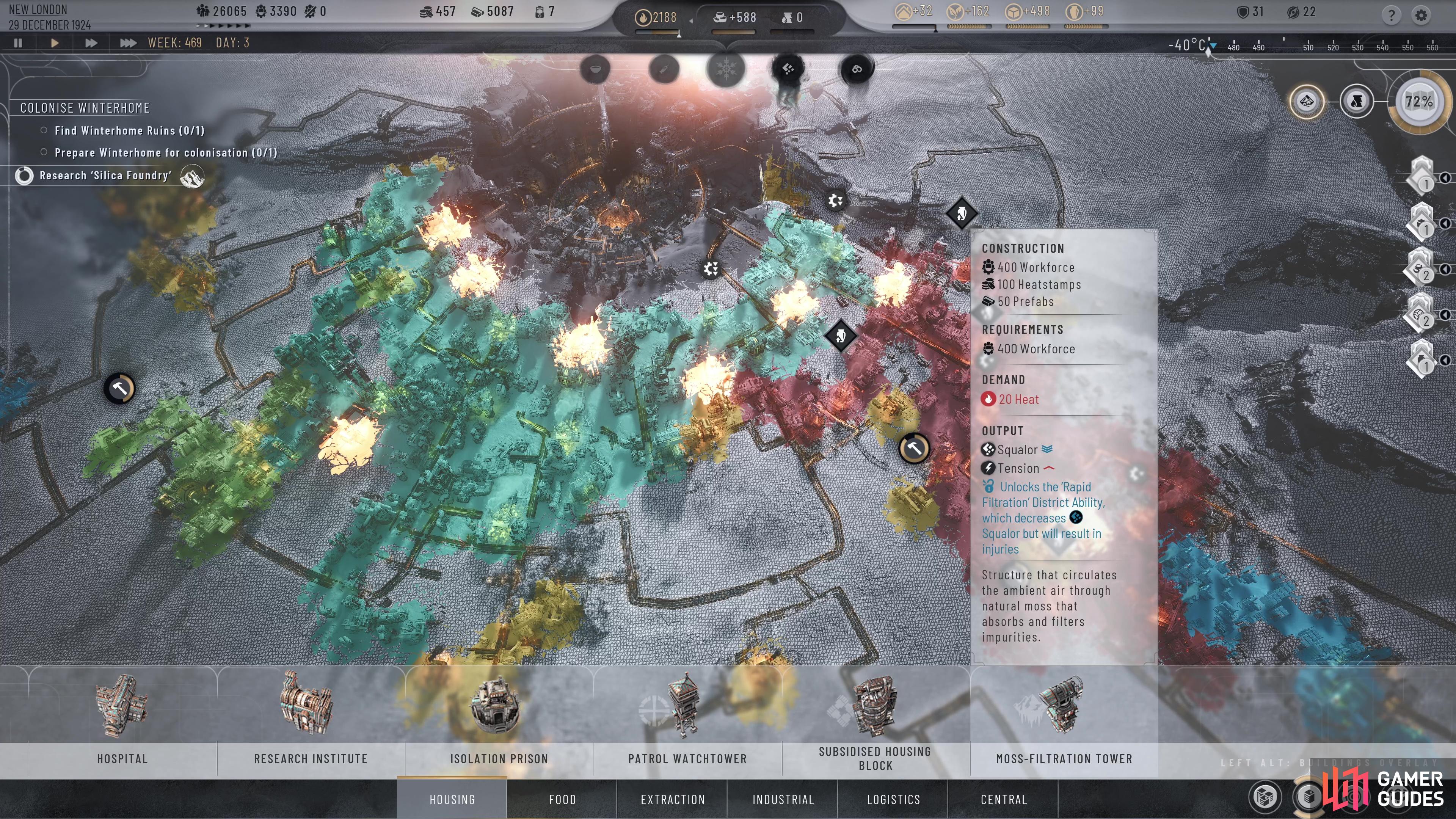Managing New London in Frostpunk 2 comes with all kinds of trials and tribulations, and preventing the Squalor from rising too much is one of the more critical duties. High Squalor will see Tension rise in New London, among many other debilitations so knowing how to decrease it (and what increases it in the first place) is of the utmost importance. Keep reading to learn how to deal with Squalor effectively in Frostpunk 2.
Squalor plays a large role in the day-to-day running of New London in Frostpunk 2.
What Increases Squalor?¶
In order to reduce Squalor in New London, it’s first important to understand what is causing it to rise in the first place. The most obvious place to start, is of course, the main ideology you’re choosing to pursue throughout your construction, laws, and research. The main stickler here being the Progress ideology which, as you may expect, focuses on technological growth at the cost of all others.
On the other hand, opting for more Adaptation research and laws will often see Squalor decrease at the cost of a greater Workforce usually. It’s a delicate balancing act that you must get right, especially if you don’t want to upset one of the Communities/Factions. Below, you’ll find a full list of what increases Squalor in Frostpunk 2:
- Researching or Constructing most things favoring Progress
- Not meeting the demand for Materials
- Poor placement of Districts
Decreasing Squalor¶
Now that you know the main culprits for Squalor raising, how do you go about reducing it so that it’s not a problem? Well, there are a few ways you can go about it, and you’ll find more details on them below.
Meeting Materials Demand¶
One of the more obvious methods for decreasing that Squalor is by meeting the Materials demand for the city/colony, which can really get out of hand as it grows in size. There are a few ways you can increase your Material intake, not least placing Extraction Districts on Material deposits and using buildings such as Sawmills to increase that output (just beware this will increase Squalor).
Alternatively, you can send Frostland teams out into the winter wasteland and find large deposits or settlements of Materials that you can then send back to New London or a Colony by setting up a trail, or more ideally, a Skyway (which requires you to research first). This is the most effective method of increasing your Materials intake.
Finally, if you’re still finding it hard to meet the demand of Materials, especially in something like a Whiteout, you can always turn down the output of a District a little which in turn decreases the Materials demand (along with heat).
(1 of 2) Take a look at how much demand there is for Materials throughout the city.
Take a look at how much demand there is for Materials throughout the city. (left), Then go to certain districts and decrease the output to lower the demand for a while. (right)
Filtration Towers and Waste Management Facilities¶
Once you’ve got your first Research Institute built, you’ll gain access to the Idea Tree, which, among other useful tools, will allow you to start investing in means to decrease your Squalor. With these researched, you can then expand a Housing District to build Filtration Towers or an Industrial District to build Waste Management Facilities.
You’ll find variants for both Progress and Adaptation and as you may expect, the Progress one will give you larger decreases but at the expense of still raising Squalor. Once you have a Filtration Tower too, you can select a District with it in it and make use of the ability to temporarily reduce a burst of Squalor.
District Placement¶
You’re given the information early on that it pays to have Districts placed next to each other to give them a Heat bonus, and while that’s true for the most part, if you employ this strategy with every District, you’re going to run into trouble fast.
The biggest offender to this is placing Extraction or Industrial Districts close to other Districts, but especially your Housing Districts. Both of these Districts generate Squalor and placing them in close proximity will help to raise Squalor in the neighboring Districts so be sure to put some space between them. If you want to see how much Squalor you’re spreading to other Districts, hold in the ALT key to get a nice handy overview of it.
(1 of 2) Filtration Towers in Housing District can help you quickly clear Squalor.
Filtration Towers in Housing District can help you quickly clear Squalor. (left), Fully embracing Progress will unlock the powerful Squalor cleansing Automation Primacy ability. (right)
Progress Cornerstone Ability¶
The final method is the most extreme, but also the most effective tool you could possibly have available to you. It’ll take some time to get there, but should you fully embrace Progress in New London, by favoring proposals and researching ideas that favor the New Londoners, you’ll gain access to a powerful Cornerstone ability accessed in the Idea Tree.
This will unlock the Automation Primacy ability, which will allow you to use the “Release the Swarm” ability for your city. When used, you will release Automations throughout New London that will increase efficiency but, more importantly, greatly reduce Squalor. There is a caveat to this incredible ability though, not only will you have to forsake any Factions and Communities that favor Adaptation, but there is also a chance for civilians to get hurt as a result of the Automations being in the city.






 Sign up
Sign up
No Comments